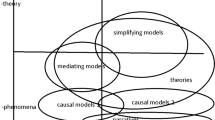Abstract
This essay addresses issues concerningexplanation by exploring how explanatorystructures function within contemporarychemistry. Three examples are discussed:explanations of the behavior of gases using theideal gas law, explanations of trends inchemical properties using the periodic table,and explanations of molecular geometry usingdiagrammatic orbital schemes. In each case,the general explanatory structure, rather thanparticular explanations, occupies center stagein the analysis. It is argued that thisquasi-empirical investigation may be morefruitful than previous analyses that attempt toisolate the essential features of individualexplanations. There are two reasons for thisconclusion, each discussed in some detail. First, the traditional analyses rely on highlyprecarious reasoning. Second, empiricallygrounded investigations provide a more naturalconnection to the core aim of analyses ofexplanation, namely to provide a rationale forthe widely expressed preference for explanatorytheories in science.
Similar content being viewed by others
REFERENCES
N. Cartwright. How the Laws of Physics Lie. New York: Oxford University Press, 1983.
J. Dalton. A New System of Chemical Philosophy. London: Peter Owen Limited, 1808.
M. Friedman. Explanation and Scientific Understanding. Journal of Philosophy 71: 5–19, 1974.
C.G. Hempel and P. Oppenheim. Studies in the Logic of Explanation. In C.G. Hempel (Ed.), Aspects of Scientific Explanation and Other Essays, pp. 245–290. New York: The Free Press, 1965.
Y. Jean and F. Volatron. An Introduction to Molecular Orbitals, J. Burdett (Transl. and Ed.). New York: Oxford University Press, 1993.
P. Kitcher. Explanatory Unification and the Causal Structure of the World. In P. Kitcher and W. Salmon (Eds.), Scientific Explanation, pp. 410–505. Minneapolis: University of Minnesota Press, 1989.
B.H. Mahan. University Chemistry. Reading, MA: Addison-Wesley Publishing Company, 1975.
H. Primas. Chemistry, Quantum Mechanics and Reductionism: Perspectives in Theoretical Chemistry. Berlin: Springer, 1983.
J.L. Ramsey. Molecular Shape, Reduction, Explanation and Approximate Concepts. Synthese 111: 233–251, 1997.
W.C. Salmon. Scientific Explanation and the Causal Structure of the World. Princeton, NJ: Princeton University Press, 1984.
J. van Brakel. Philosophy of Chemistry: Between the Manifest and the Scientific Image. Leuven, Belgium: Leuven University Press, 2000.
B.C. van Fraassen. The Scientific Image. Oxford: Clarendon Press, 1980.
S.J.Weininger. TheMolecular Structure Conundrum:Can Classical Chemistry be Reduced to Quantum Chemistry? Journal of Chemical Education 61: 939–944, 1980.
R.G.Woolley. Must aMolecule Have a Shape? Journal of the American Chemical Society 100: 1073–1078, 1978.
Author information
Authors and Affiliations
Rights and permissions
About this article
Cite this article
Woody, A.I. Telltale Signs: What Common Explanatory Strategies in Chemistry Reveal about Explanation Itself. Foundations of Chemistry 6, 13–43 (2004). https://doi.org/10.1023/B:FOCH.0000020993.09368.b6
Issue Date:
DOI: https://doi.org/10.1023/B:FOCH.0000020993.09368.b6




